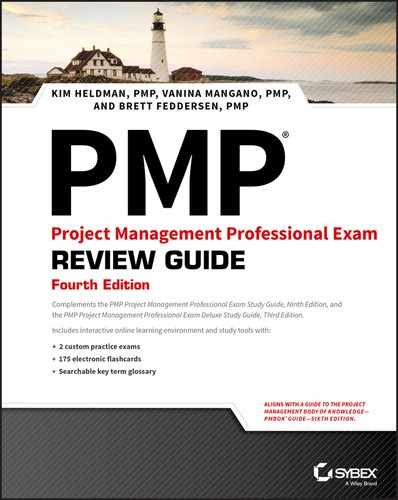Chapter 1
Project Foundation
THE PMP® EXAM CONTENT FROM THE INITIATING THE PROJECT PERFORMANCE DOMAIN COVERED IN THIS CHAPTER INCLUDES THE FOLLOWING:
 1.1 Be able to describe the difference between projects and operations.
1.1 Be able to describe the difference between projects and operations. Be able to differentiate between project management, program management, portfolio management, and a project management office.
Be able to differentiate between project management, program management, portfolio management, and a project management office. Be able to list some of the skills every good project manager should possess.
Be able to list some of the skills every good project manager should possess. Be familiar with the components of the PMI Talent Triangle.
Be familiar with the components of the PMI Talent Triangle. Be able to define the role of the project manager.
Be able to define the role of the project manager. Be able to differentiate between the organizational structures and the project manager’s authority in each.
Be able to differentiate between the organizational structures and the project manager’s authority in each. Be able to name the five project management process groups.
Be able to name the five project management process groups.
 Much of the focus and content of this book revolves heavily around the information contained in A Guide to the Project Management Body of Knowledge, Sixth Edition (PMBOK® Guide), published by the Project Management Institute (PMI®). Because many exam questions will relate to the content of the PMBOK® Guide, it will be referenced throughout this book, and we’ll elaborate further on those areas that appear on the test.
Much of the focus and content of this book revolves heavily around the information contained in A Guide to the Project Management Body of Knowledge, Sixth Edition (PMBOK® Guide), published by the Project Management Institute (PMI®). Because many exam questions will relate to the content of the PMBOK® Guide, it will be referenced throughout this book, and we’ll elaborate further on those areas that appear on the test.
This chapter lays the foundation for building and managing a project. Understanding project management from a broad and high-level perspective is important and will prepare you to digest the rest of the information in this book. One of the concepts you will learn is that of progressive elaboration, which PMI® defines as an iterative process of increasing the level of detail in a project management plan as information and accurate estimates become available. In this context, we want to start with an overview of the general framework in which projects operate, and then we will get progressively more elaborate with defining what those steps entail.
Defining a Project
Pop quiz: How do you tell the difference between a project and ongoing operations? Before delving into the aspects of project management, it’s important to determine whether what you are dealing with is, in fact, a project. Projects are often confused with ongoing operations, and it’s therefore important to understand how to define a project and know its characteristics.
Once you have determined that you are dealing with a project, all stakeholders will need to be identified. To be considered successful, a project must achieve its objectives and meet or exceed the expectations of the stakeholders.
Project Characteristics
According to the PMBOK® Guide, the characteristics of projects, as shown in Figure 1.1 , are as follows:
- They are temporary in nature and have a definite start and finish.
- They produce a unique product, service, or result that didn’t exist before.
- They often drive change within organizations.
- They typically enable the creation of business value.
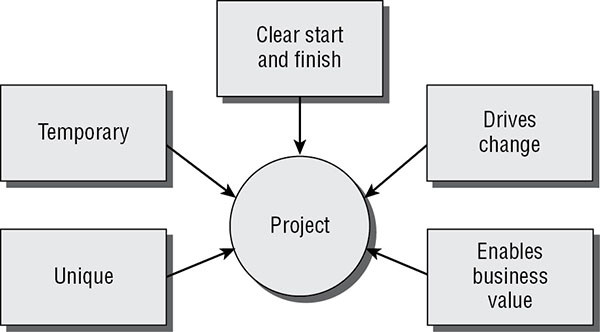
FIGURE 1.1 Project
The unique deliverables from a project might include tangible products (a road or a building); well-defined and specific services, such as consulting or project management; and business functions that support the organization. Projects might also produce a result or an outcome, such as a document that details the findings of a research study. The purpose of a project is to achieve its goals and to conclude. Therefore, a project is considered complete when one of the following occurs:
- The goals and objectives are accomplished to the satisfaction of the stakeholders.
- It has been determined that the goals and objectives cannot be accomplished or are no longer needed.
- The project is canceled due to lack of resources (i.e., funding, people, or physical resources) or for legal reasons.
After its completion, a project’s product, service, or result may become part of an ongoing operation.
Operations
Operations are ongoing, are repetitive, and involve work that is continuous without an end date. Often, operations involve repeating the same processes and producing the same results. Figure 1.2 shows the characteristics of operations. The purpose of operations is to keep the organization functioning.
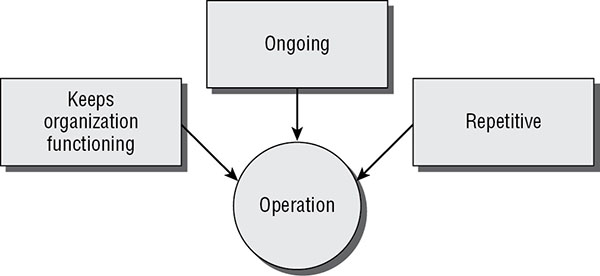
FIGURE 1.2 Operations
Unsure whether it is a project or an ongoing operation? Put it through the following test to make a determination:
- Is it unique?
- Does the work effort have a limited time frame?
- Is there a way to determine when the project is completed?
- Is there a way to determine stakeholder satisfaction?
If you answered yes to each question, then it is a project.
Progressive Elaboration
Progressive elaboration means the characteristics of the product, service, or result of the project are determined incrementally and are continually refined and worked out in detail as the project progresses. Product characteristics are typically broad-based at the beginning of the project and are iterated into more and more detail over time until they are complete and finalized.
Stakeholders
A stakeholder is any person or group, including formal organizations, who are impacted by the project, who believe themselves to be impacted, or who can directly impact the project. The following are characteristics of various stakeholders:
- They are individuals, groups, or organizations with a vested interest in the project.
- They are actively involved with the work of the project.
- They have something to either gain or lose as a result of the project.
Identifying who these stakeholders are is not a onetime process, and it’s important to identify stakeholders at the onset of the project. Here are some examples of project stakeholders, as shown in Figure 1.3 :
- Customer
- Sponsor
- Contractors
- Suppliers
- Project manager
- Project team members
- Department managers
- Project management office (PMO)

FIGURE 1.3 Stakeholders
It’s also important to note that stakeholders might have conflicting interests and that it is the project manager’s responsibility to manage stakeholder expectations. When in doubt, stakeholder conflicts should always be resolved in favor of the customer.
The project sponsor, who is also a stakeholder, is generally an executive in the organization with the authority to assign resources and enforce decisions regarding the project. The project sponsor typically serves as the tiebreaker decision maker and is one of the people on the project’s escalation path.
Stakeholders are identified early on within the life of the project and may change as the project evolves. Failure to identify stakeholders can result in failure of the project itself because unidentified stakeholders might not have their expectations satisfied if you do not give them a voice. Understanding the level of influence of each stakeholder is also critical to the success of the project.
Defining Project Management
A project management framework provides the tools and techniques necessary for the successful initiation, planning, and execution of a project. Project management is the application of that framework to consistently deliver products and services to a stakeholder’s satisfaction. Project management may involve more than a single project. In the bigger picture, a project may be part of a program, a portfolio, and/or a PMO.
Project Management
According to the PMBOK® Guide, project management is “the application of knowledge, skills, tools, and techniques to project activities to meet the project requirements.”
Project managers are the people responsible for managing the project processes and applying the tools and techniques used to carry out the project activities. It is the responsibility of the project manager to ensure that project management techniques are applied and followed. In addition to this, project management is a process that includes initiating a new project, planning, putting the project plan into action, and measuring and reporting on performance. It involves identifying the project requirements, establishing project objectives, balancing constraints, and taking the needs and expectations of the key stakeholders into consideration.
Project management itself can exist beyond the management of a single project. In some organizations, programs and portfolios are also managed. Figure 1.4 shows the characteristics of a project, program, and portfolio as well as a PMO.
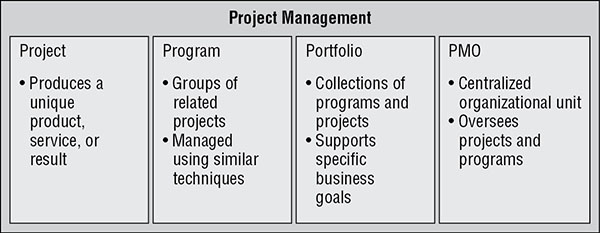
FIGURE 1.4 Project management overview
Programs
According to the PMBOK® Guide, programs are groups of related projects, subsidiary programs, and program activities that are managed in a coordinated way to obtain benefits not available from managing them individually.
In many cases, projects within a program have their own project manager(s), who report to a program manager. All the projects are related and are managed together so that collective benefits are realized and controls are implemented and managed in a coordinated fashion. The management of this collection of projects—determining their interdependencies, managing their constraints, and resolving issues among them—is called program management.
Portfolios
Portfolios are collections of projects, programs, subsidiary portfolios, and operations managed as a group to achieve strategic objectives. Programs and projects included as part of a portfolio may not necessarily relate to one another in a direct way.
Portfolio management encompasses managing the collection of programs, projects, other work, and sometimes other portfolios. It also concerns monitoring active projects for adherence to objectives, balancing the portfolio among the other investments of the organization, and ensuring the efficient use of resources.
Project Management Office
The project management office (PMO) is a centralized organizational unit that oversees or guides the management of projects and programs throughout the organization.
While there are different types of PMOs, a PMO is generally responsible for the following:
- Standardizing project-related governance processes
- Standardizing project management processes, tools, and techniques
- Managing the objectives of a collective set of projects
- Managing shared resources across the projects
- Managing the interdependencies of all the projects within its authority
- Maintaining and archiving project documentation for future reference
- Measuring project performance of active projects and suggesting corrective actions
- Evaluating completed projects for their adherence to the project plan
- Suggesting corrective actions pertaining to projects and programs as needed
The most common reason a company starts a project management office is to establish and maintain procedures and standards for project management methodologies and to manage resources assigned to the projects in the PMO. Project managers and team members may report directly to the PMO, or the PMO may provide support functions for projects and project management training or simply have experts available to provide assistance.
According to the PMBOK® Guide, there are several types of PMOs:
- Supportive, which provide resources and guidance on following project management best practices
- Controlling, which ensure adherence to policy and published framework or methodologies
- Directive, where project managers report directly into the PMO organization
Figure 1.5 shows the three common types of PMOs.
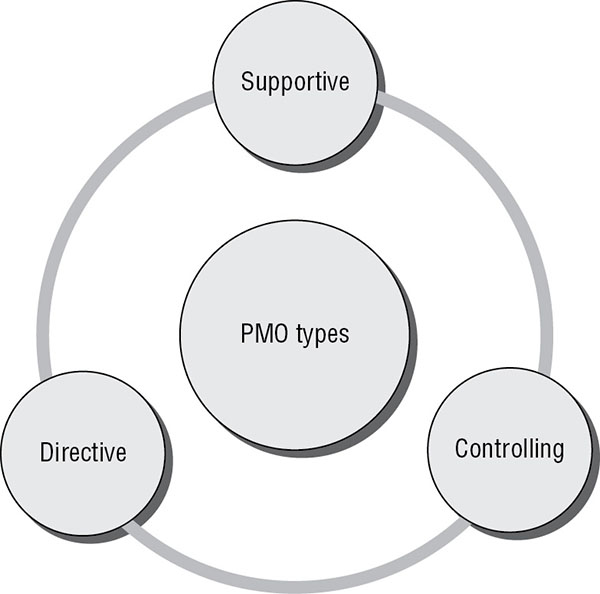
FIGURE 1.5 Common types of PMOs
The overall purpose of a project manager and PMO differ to a certain extent. A project manager is focused on the project at hand, whereas the PMO takes more of an organizational approach to project management. The project manager is concerned with the project’s objectives; the PMO is concerned with the organizational objectives. Table 1.1 outlines the differences between the overall objectives and perspectives of a project manager and PMO.
TABLE 1.1 Project manager vs. PMO
| Project manager | PMO | |
| Overall goal | Achieve the project requirements | Achieve goals from an enterprise-wide perspective |
| Objective | Deliver project objectives | Deliver organizational objectives |
| Resources | Manage project resources | Optimize shared resources |
| Reporting | Project reporting | Consolidated reporting |
PMOs can exist in any type of organizational structure. A major benefit for project managers working in an organization that has an existing PMO is the room for advancement that a PMO provides.
Although PMOs are common in organizations today, they are not required in order to apply good project management practices.
Identifying Project Management Skills
To be successful, a project manager must possess general management skills that span every area of management—from accounting and strategic planning to supervision, personnel administration, and so forth. Some projects also require specific skills in certain application areas, such as within an industry group, within a department, or by technical specialty. These skills prepare the project manager to communicate, solve problems, lead, and negotiate throughout a project.
As shown in Figure 1.6 , seven general management skills make up the foundation of good project management practices.
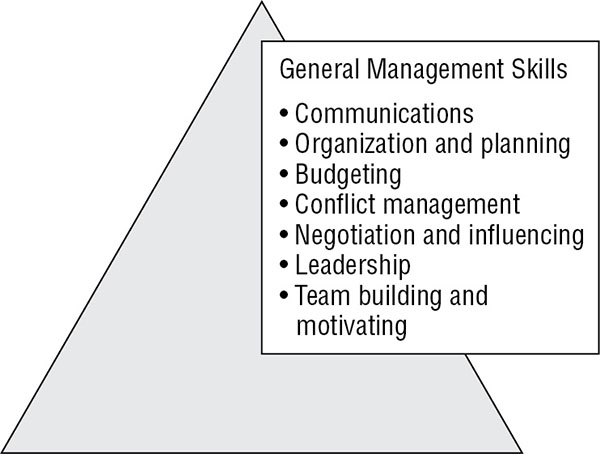
FIGURE 1.6 General management skills
Communication Skills Many forms of communication exist within a project and are critical to its success. It is the job of the project manager to ensure that the information is explicit, clear, and complete. Once the information has been distributed, it is the responsibility of the recipient to confirm that the information has been understood. Good project managers spend up to 90 percent of their time communicating. This makes communication skills a critical asset for a project manager.
Organization and Planning Skills Organization and planning skills are closely related and an important skill set that a project manager should possess. Project managers must track and locate many documents, meetings, contracts, and schedules. Doing so requires time management skills, which is why this skill set is tied closely to organization skills. Because there isn’t any aspect of project management that doesn’t first involve planning, it will be an area discussed extensively throughout this book.
Budgeting Skills Project managers establish and manage budgets and are therefore expected to have some knowledge of finance and accounting principles. Cost estimates are an example of when budgeting skills are put to use. Other examples include project spending, reading and understanding vendor quotes, preparing or overseeing purchase orders, and reconciling invoices.
Conflict Management Skills Conflict management involves problem solving, first by defining the causes of the problem and then by making a decision to solve it. After examining and analyzing the problem, the situation causing it, and the available alternatives, determine the best course of action. The timing of the decision is also important.
Negotiation and Influencing Skills Both negotiation and influencing skills are necessary in effective problem solving and are used in all areas of project management. The following terms are related to this skill set:
- Negotiation Whether one on one or with teams of people, negotiation involves working with others to come to an agreement and is necessary in almost every area of the project.
- Influencing Influencing requires an understanding of the organization’s structure and involves convincing the other party to consider the choice you think is the better one even if it is not what they want.
- Power Power is a technique used to influence people and is the ability to get people to do things they wouldn’t otherwise do.
- Politics Politics involves getting groups of people with different interests to cooperate creatively even in the midst of conflict and disorder.
Leadership Skills Leadership involves exhibiting characteristics of both a leader and a manager and knowing when to switch from one to the other throughout the project. A leader imparts vision, gains consensus for strategic goals, establishes direction, and inspires and motivates others. Managers focus on results and are concerned with getting the job done according to requirements.
Team Building and Motivating Skills The project manager sets the tone for the project team and walks the team members through various stages of team development to become fully functional. This can involve team-building groundwork and motivating the team even when team members are not direct reports.
PMI® publishes what is referred to as the PMI Talent TriangleTM, which breaks out the skills a project manager needs in order to be effective. As demonstrated in Figure 1.7 , the Talent Triangle consists of three key sets of skills:
- Technical project management, which refers to the skills needed in order to apply project management knowledge effectively to produce the desired results for a project. Examples are producing project management artifacts; tailoring project management methodologies, tools, and techniques; and managing against scope, budget, and schedule constraints.
- Leadership, which refers to the ability to direct, guide, and motivate others, as described previously in this section.
- Strategic and business management, which refer to skills needed to see the big picture of what an organization is aiming to accomplish and implement decisions that support strategic initiatives. Examples are understanding business benefits of a project, communicating effectively with the project sponsor and team, and maximizing the business value of the project.
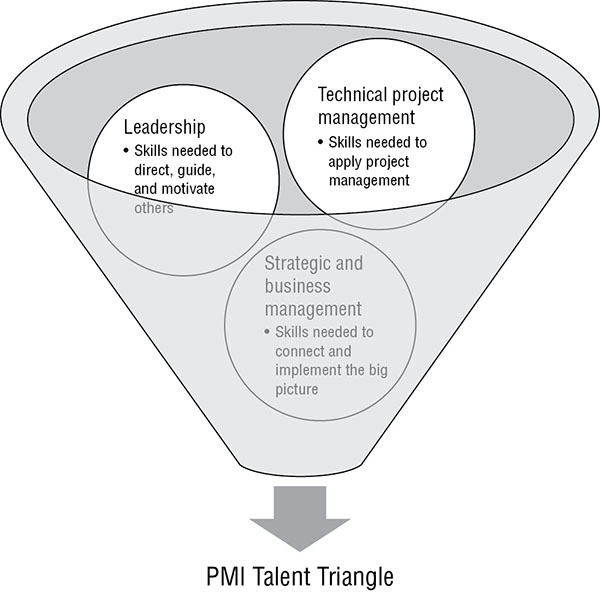
FIGURE 1.7 PMI Talent TriangleTM
Understanding the Role of the Project Manager
The role of the project manager is essential to the successful outcome of a project. As noted throughout this chapter, the project manager plays a different role than that of a functional manager or operations manager, although they often interact closely with these other key roles connected to the project. The role of project manager is defined by the PMBOK® Guide as “the person assigned by the performing organization to lead the team that is responsible for achieving the project objectives.”
Project managers are tasked with achieving the objectives of a project and meeting the expectations of stakeholders. This requires that the project manager balance several competing constraints and effectively communicate with various stakeholders within and outside of their project. As noted earlier, communication is a key skill that every effective project manager excels in.
According to the PMBOK® Guide, good project managers work toward achieving the following within their organization:
- Increasing project management competency and capability
- Demonstrating the value of project management
- Increasing the acceptance of project management
- Advancing the effectiveness of the PMO, if one exists
Understanding Organizational Structures
Like projects, organizations are unique, each with its own style and culture—both have an influence on how projects are performed. Organizations in general can be structured in several different ways, including hybrids of the various types. For example, in some organizational types, the role of the project manager is not formal, and project management responsibilities are absorbed into other functional roles. In others, the role of the project manager is formal, and they may hold a high level of authority. In the past, three organizational structures were highlighted:
- Functional
- Matrix
- Projectized
According to the PMBOK® Guide, variations and combinations of these organizational structures exist, including multidivisional organizations, virtual, hybrid, and PMO. Figure 1.8 provides a simplified view of the primary three structures and where they fall in relation to one another, including the variations (weak, balanced, and strong) that exist in matrix organizations. Knowing the type of structure that an organization operates within is important and impacts how a project manager may proceed. One of the biggest determining factors of an organization’s structure is the authority that a project manager holds.

FIGURE 1.8 Simplified spectrum of organizational types
Since functional and projectized are the two extreme types of organizational structures, we’ll cover them first.
Organizational Structure Types
Of the various organizational structures noted, there are two that reflect opposite ends of the spectrum: functional organizations and projectized organizations, also referred to as project-oriented organizations.
Functional Organizations Functional organizations are the oldest style of organization; the functional style is known as the traditional approach to organizing businesses. These types of organizations have the following characteristics:
- They center on specialties.
- They are grouped by function.
- They are displayed as a hierarchy.
Importantly, workers within a functional organization specialize in an area of expertise, which allows them to become very good in a particular specialty (such as accounting, human resources, or engineering).
Within this hierarchical structure, a chain of command exists in which employees report to one manager and one person is ultimately in charge at the top. Each department or group is managed independently and has a limited span of control, therefore requiring that the chain of command be followed when input from another department on a project is needed. The mind-set behind this type of structure is that people with similar skills and experiences are easier to manage as a group, allowing for work assignments to be distributed and managed easily, and supervisors are experienced in the area they supervise.
Table 1.2 highlights the advantages and disadvantages of a functional organization.
TABLE 1.2 Functional organizations
| Advantages | Disadvantages |
| There is an enduring organizational structure. | Project managers have little to no formal authority. |
| There is a clear career path with separation of functions, allowing specialty skills to flourish. | Multiple projects compete for limited resources and priority. |
| Employees have one supervisor with a clear chain of command. | Project team members are loyal to the functional manager. |
Projectized Organizations Projectized organizations, also referred to as project-oriented organizations, are nearly the opposite of functional organizations, focusing on the project itself and therefore developing loyalties to the project and not to a functional manager.
Project managers have high to ultimate authority within this type of organization and typically report directly to the CEO. The project manager makes decisions regarding the project, including dealing with constraints. As a side note, project managers in all organizational structures must balance competing project constraints such as these:
- Scope
- Quality
- Schedule
- Budget
- Resources
- Risk
Within a projectized organization, teams are often co-located, meaning that team members physically work at the same location and report to the project manager. Once the project is completed, the team is often dissolved and members are either put on the bench or let go. Resource utilization can be inefficient if a highly specialized skill is needed only at given times throughout the project and sits idle during other times.
Table 1.3 highlights the advantages and disadvantages of a projectized organization.
TABLE 1.3 Projectized organizations
| Advantages | Disadvantages |
| Project managers have high to ultimate authority. | Project team members may find themselves out of work after project completion. |
| Project team members are loyal to the project. | There can be inefficiency with resource utilization. |
Matrix Organizations Matrix organizations are a blend of functional and projectized organizations, taking advantage of the strengths of both and combining them into one. Employees report to a functional manager and to at least one project manager.
Functional managers assign employees to projects and handle administrative duties, whereas project managers execute the project and assign project activities to employees. Both share the responsibility of performance reviews.
Within matrix organizations exists a balance of power ranging from that of a functional organization to that of a projectized organization:
- Strong Matrix A strong matrix organization has characteristics of a projectized organization, where the project manager has a high level of authority and can dictate resources.
- Weak Matrix On the other end of the spectrum is the weak matrix, which holds a resemblance to a functional organization in that the functional managers have a greater level of power and tend to dictate work assignments.
- Balanced Matrix In between a strong matrix and weak matrix is the balanced matrix, where the power is balanced between the project managers and functional managers.
Table 1.4 shows the subtle differences between the three types of matrix organizations. The majority of organizations today are a composite of functional, projectized, and matrix structures.
TABLE 1.4 Comparing matrix structures
| Weak Matrix | Balanced Matrix | Strong Matrix | |
| Project manager’s title | Project coordinator, project leader, or project expeditor | Project manager | Project manager |
| Project manager’s focus | Split focus between project and functional responsibilities | Projects and project work | Projects and project work |
| Project manager’s power | Minimal authority and power | Balance of authority and power | Significant authority and power |
| Project manager’s time | Part-time on projects | Full-time on projects | Full-time on projects |
| Organization style | Most like functional organization | Blend of both weak and strong matrix | Most like a projectized organization |
| Project manager reports to | Functional manager | Functional manager, but shares authority and power | Manager of project managers |
Understanding the Project Environment
The project environment is made up of internal and external factors that influence a project. When managing a project, the project manager must consider more than just the project itself. Proactively managing a project involves understanding the environment in which the project must function.
The following are some examples of the elements that make up the project environment:
Organizational Structure The organizational structure itself plays a large role in how a project is managed and is a major influential factor within the project environment. This is intermingled with the company culture.
Physical Environment The physical environment includes considerations such as the following:
- Local ecology
- Physical geography
- Environmental restrictions, such as protected areas or protected wildlife
- Amount of dedicated office and conference room space
Cultural and Social Environment When referencing the cultural environment, consider these various layers:
- Corporate culture, including external stakeholders and vendors. This is intermingled with organizational structures but can take on a life of its own.
- Ethnic culture.
- Religious culture.
- Organizational risk tolerance.
To communicate effectively with customers, stakeholders, and project team members, it becomes necessary to understand cultural and social factors and how they can impact a project. In particular, cultural differences pose a common communication obstacle within projects. As virtual and global projects become a more common scenario, understanding how to function within this type of environment becomes critical.
A project manager should also understand how the project impacts individuals and how individuals impact the project.
International and Political Environment The international and political environment involves considering the following:
- International, national, regional, and local laws and regulations
- Norms and customs
- Political climate
- Time zone and local holidays
It is important for a project manager to know, from the onset of the project, whether any of the items listed affect their particular project. Something as minor as a time zone difference or as large as the political climate can have a huge impact on a project.
There are other influential factors far beyond those listed here, and the list can become quite extensive. On a basic level, these factors provide you with an overview of a project from a broader perspective.
Understanding Project Life Cycles and Project Management Processes
Most projects begin with an idea. After soliciting support and obtaining approval, a project progresses through the intermediate phases to the ending phase, where it is completed and closed out. As a project passes through this life cycle, it is carried out through a set of project management processes. According to the PMBOK® Guide, these processes are interrelated and dependent on one another; they are divided into five project management process groups:
- Initiating
- Planning
- Executing
- Monitoring and Controlling
- Closing
Each of these process groups displays characteristics that reflect the level of a project’s costs, staffing, chances for successful completion, stakeholder influence, and probability of risk.
Figure 1.9 shows the project management process groups and represents the life cycle of a project or project phase.
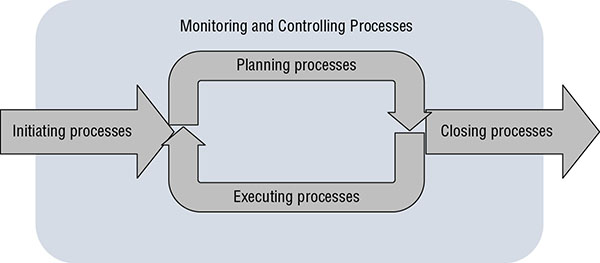
FIGURE 1.9 Project management process groups
Project Phases and Project Life Cycles
Most projects are divided into phases. Project phases consist of segments of work, and a project may have one or many phases, depending on the project complexity and industry. The phases that a project progresses through are collectively called the project life cycle. Project life cycles are similar for all projects, and the phases that occur within the project life cycle can vary, such as being sequential or overlapping.
All projects generally follow the same life-cycle structure:
- Starting the project, or initiating
- Organizing and preparing, or planning the work of the project
- Carrying out (or performing) the work of the project, or executing
- Closing out the project
A development life cycle often has one or more phases that are connected to the creation or output of the product, service, or result. According to the PMBOK® Guide, these life cycles can follow predictive, iterative, incremental, adaptive, or hybrid models.
Predictive Life Cycles In a predictive life cycle, planning generally occurs at the front end of the project and changes to scope follow a change control process. These types of life cycles are also commonly referred to as plan driven.
Iterative Life Cycles Iterative life cycles are similar to predictive in that planning occurs at the front end of the project. The difference is that estimates (such as time and cost) are refined as the project proceeds forward and the team gains a greater understanding of the project’s end result. Incremental additions to functionality through repetitive cycles are common.
Incremental Life Cycles Incremental life cycles produce deliverables through a set of iterations that add functionality within an established time frame. The deliverable, or end result, is considered to be complete after the final iteration occurs.
Adaptive Life Cycles In an adaptive life cycle, deliverables are also produced through a set of iterations, similar to an incremental life cycle, although a detailed scope is determined prior to the start of an iteration. With an adaptive life cycle, the end of an iteration produces a usable deliverable. This life cycle is considered to be agile.
Hybrid Life Cycle A hybrid life cycle is a combination of predictive and adaptive. A high level of planning occurs at the front end of the project for known elements of the project; other elements that are unknown at the start are planned in an iterative fashion and follow a more adaptive approach.
Figure 1.10 outlines the characteristics of each of the development life cycles.
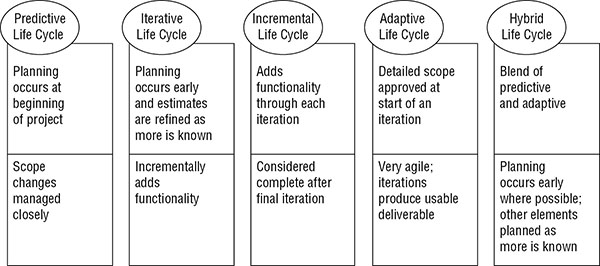
FIGURE 1.10 Development life cycles
At the beginning of a phase, a feasibility study may be carried out. At the end of a phase, a phase gate or phase-end review of the accomplished deliverables may be performed before handoff to the next phase can occur. The following list expands further on several key terms used within this description of what occurs within a phase:
Handoffs For the project to progress from one phase to the next, the phase deliverables should be reviewed for accuracy and approved. As each phase is completed, it’s handed off to the next phase. Handoffs, or technical transfers, are phase sequences that signal the end of one phase and typically mark the beginning of the next.
Feasibility Studies Some projects incorporate feasibility studies in the beginning phase. They are completed prior to the beginning of the next phase. A feasibility study determines whether the project is worth undertaking (or worth continuing if it is performed at a project checkpoint) and whether it will be profitable to the organization.
Deliverables Each phase has at least one deliverable that marks the phase completion. A deliverable is a tangible output that can be measured and must be produced, reviewed, and approved to bring the phase or project to completion.
Phase-End Reviews At the end of a phase, a phase-end review may take place so that those involved with the work can determine whether the project should continue on to the next phase. Phase-end reviews (also known as phase exits, phase gates, milestones, stage gates, decision gates, and kill points) give the project manager the ability to identify and address errors discovered during the phase.
Phase-to-Phase Relationships As previously indicated, a project can consist of one or more phases. There are generally three types of phase-to-phase relationships:
- Sequential relationships, where one phase must finish before the next phase can begin
- Overlapping relationships, where one phase starts before the prior phase completes
- Iterative relationships, where work for subsequent phases is planned as the work of the previous phase is performed
The act of overlapping phases to shorten or compress the project schedule is called fast-tracking. This means that a later phase is started prior to completing and approving the phase or phases that come before it.
Project Management Process Groups
Project management processes organize and describe the work of the project. As mentioned earlier, the following are the five process groups described in the PMBOK® Guide:
- Initiating process group
- Planning process group
- Executing process group
- Monitoring and Controlling process group
- Closing process group
These processes are performed by people; they are interrelated, are dependent on one another, and include individual processes that collectively make up the group. The five process groups are iterative and might be revisited and revised throughout the project’s life as the project is refined.
The project manager and the project team are responsible for tailoring, which involves determining which processes within each process group are appropriate for the project. When the project is tailored, its size and complexity and various inputs and outputs are taken into consideration. The conclusion of each process group allows the project manager and stakeholders to reexamine the business needs of the project and determine whether the project is satisfying those needs.
Initiating Process Group The processes within the Initiating process group occur at the beginning of the project and at the beginning of each project phase for large projects. This process group grants the approval to commit the organization’s resources to working on the project or phase and authorizes the project manager to begin working on the project.
The Initiating process group contains the following actions:
- Developing the project charter, which formally authorizes the project
- Identifying project stakeholders
Planning Process Group The Planning process group includes processes that formulate and revise project goals and objectives. It is also where the project management plan that will be used to achieve the goals the project was undertaken to address is created. Within this process group, project requirements are fleshed out and additional stakeholders are identified. Because projects are unique, planning must encompass all areas of project management.
The Planning process group contains the following actions:
- Developing the project management plan
- The project management plan itself contains several subsidiary plans and baselines. This collection of plans defines how the project will be planned, carried out, and closed.
- Collecting project requirements
- The project requirements define and document the needs of the stakeholders.
- Developing the project and product’s scope
- Creating the work breakdown structure (WBS)
- The WBS contains a decomposition of the project work, from the major deliverables down to the work packages.
- Identifying the project activities necessary to carry out the project work
- Developing the order and duration of project activities
- Calculating the number of resources needed to carry out the project activities
- Creating the project schedule
- Identifying the cost of all of the activities needed for project success
- Developing the project’s budget
- Estimating the cost of each project activity
- Identifying project risks
- This process also results in the creation of the risk register, where information about the identified risks will be documented.
- Assessing and prioritizing project risks that require further analysis or action, as well as the numerical analysis of risk on the overall project objectives
- Developing risk responses
Executing Process Group The Executing process group involves putting the project management plan into action, keeping the project plan on track, and implementing approved changes.
The project manager coordinates and directs project resources, and costs are highest here since greater amounts of time and resources are utilized during the Executing processes.
The Executing process group contains the following actions:
- Performing the work defined in the project management plan
- Ensuring that the quality standards and operational definitions outlined in the Planning process group are followed according to the quality management plan
- Auditing the quality requirements
- Obtaining the human resources needed to complete the project work
- Enhancing the skills and interactions of the project team
- Enhancing the overall team environment
- Managing the project team and enhancing its performance
- Distributing the necessary information throughout the course of the project, as outlined within the communications management plan
- Selecting the external vendors used and awarding the necessary procurement contracts
- Managing the expectations of the stakeholders
Monitoring and Controlling Process Group The Monitoring and Controlling process group is where project performance measurements are taken and analyzed to determine whether the project is aligned with the project plan. This process group tracks the progress of work being performed and identifies problems and variances within a process group and the project as a whole.
Processes from within the Monitoring and Controlling process group contain the following actions:
- Monitoring and controlling the work of the project, such as making sure the actual work performed is in line with the project management plan
- Using the integrated change control system to review, approve or deny, and manage all changes within the project
- Accepting the completed project deliverables
- Controlling the project and product scope
- This helps prevent scope creep and ensures that the project accomplishes what it set out to do.
- Controlling the project schedule to make sure the project is completed on time
- Controlling the project costs to make sure the project is completed within the allotted budget
- Monitoring the results of conducting quality activities
- This allows for an assessment of performance.
- Reporting the project performance through planned reports
- This also involves forecasting and measuring project performance.
- Implementing risk response plans
- Monitoring and controlling risks
- This includes monitoring the project for any new risks and evaluating the effectiveness of risk responses and risk management processes.
- Managing vendor relationships and vendor contracts
- Monitoring the relationships with project stakeholders and adjusting approaches as warranted
Closing Process Group The Closing process group includes processes that bring a formal, orderly end to the activities of a project phase or to the project itself. Once the project objectives have been met, all the project information is gathered and stored for future reference. The closing process group contains finalizing the project work to formally complete the project or project phase.
The progression through the project management process groups exhibits the same characteristics as progression through the project phases. Table 1.5 shows the characteristics of the process groups.
TABLE 1.5 Characteristics of the project process groups
| Initiating | Planning | Executing | Monitoring and Controlling | Closing | |
| Costs | Low | Low | Highest | Lower | Lowest |
| Staffing levels | Low | Lower | High | High | Low |
| Chance for successful completion | Lowest | Low | Medium | High | Highest |
| Stakeholder influence | Highest | High | Medium | Low | Lowest |
| Risk probability | Highest | High | Medium | Low | Lowest |
Plan-Do-Check-Act Cycle
As the project progresses and more information becomes known, the project management processes might be revisited and revised to update the project management plan. Underlying the concept that process groups are iterative is a cycle called the Plan-Do-Check-Act cycle, which was originally defined by Walter Shewhart and later modified by Edward Deming. The idea behind this concept is that each element in the cycle is results oriented and becomes input into the next cycle. The cycle interactions can be mapped to work in conjunction with the five project management process groups.
Recognizing Professional and Social Responsibility
A PMP® credential comes with several responsibilities that involve decisions and actions you make. By submitting your PMP® application, you agree to abide by the PMI® Code of Ethics and Professional Conduct. This oath touches on several elements within your personal and professional life and includes actions that are mandatory as well as actions and ideals to which we aspire.
Maintaining ethical and professional conduct applies to day-to-day activities and is therefore applicable to everything discussed earlier in this chapter and throughout the rest of the book. Meeting ethical and professional standards is an essential part of building a solid project management foundation. For the exam, you will be expected to be familiar with the code and answer questions based on its contents.
PMI® Core Values
The PMI® Code of Ethics and Professional Conduct addresses the following four elements: responsibility, respect, fairness, and honesty.
Responsibility
Responsibility is a major part of upholding integrity. It involves taking ownership for your actions, being proactive in doing the right thing, and doing what is necessary to resolve a situation that results from an initial lack of responsibility.
As shown in Figure 1.11 , a variety of elements touch on the concept of responsibility:
- Ensuring a high level of integrity
- Accepting only those assignments for which you are qualified
- Following rules, regulations, laws, and policies
- Respecting confidential information
- Upholding the PMI® code of ethics and holding fellow project managers accountable
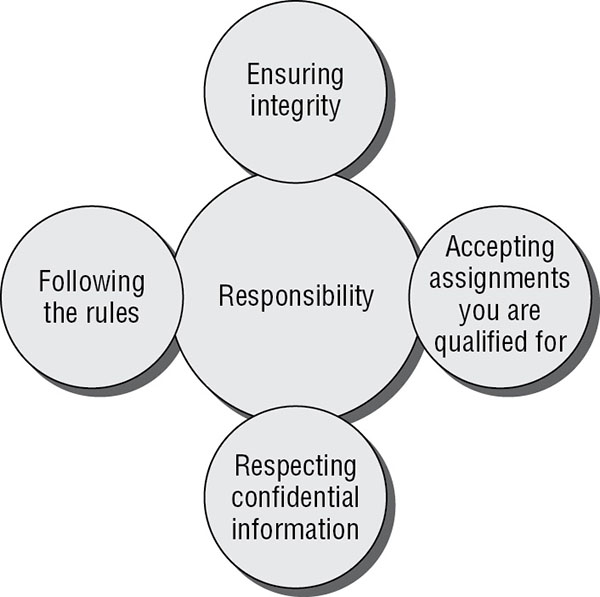
FIGURE 1.11 Elements of responsibility
Ensuring Integrity As a project manager, one of your professional responsibilities is to ensure integrity of the project management processes, the product, and your own personal conduct. This can entail the following:
- Applying the project management processes correctly to ensure integrity of the product
- Executing the process groups effectively to ensure the quality of the product
- Obtaining formal acceptance of the project and product
Accepting Assignments Accepting appropriate assignments is tied to responsibility and honesty. This involves doing the following:
- Accurately and truthfully reporting your qualifications, experience, and past performance of services to potential employers, customers, PMI®, and others
- Declining assignments beyond your capabilities or experience
- Emphasizing your knowledge and how you’ve used it in your specific industry as opposed to making others believe that you have experience using certain processes and tools if, in reality, you don’t
- Accurately representing yourself, your qualifications, and your estimates in your advertising and in person
- Completing the commitments that you undertake and ensuring that you do what you say you will do
Following the Rules It is imperative that you follow all applicable laws, rules, and regulations, including these:
- Industry regulations
- Organization rules
- Project rules
- PMI® organizational rules and policies
- Intellectual property and other ethical standards and principles governing your industry
- Local, national, and international law governing your location, processes, and product
Respecting Confidential Information Whether you are a direct employee, a consultant, or a contractor, it is likely that during the course of your project management career you will come across some form of sensitive information. You may collect or be exposed to sensitive information as part of a project. You may be required to provide such information to a contractor. You may have access to this type of information as part of your role. Whatever the situation, it is important that you comply with the PMI® Code of Ethics and Professional Conduct, which states that you agree not to disclose sensitive or confidential information or use it in any way for personal gain.
Handling company data, trade secrets, data from governmental agencies, and intellectual property are typical cases in which you will come across sensitive or confidential information. Don’t forget to ask yourself the key questions shown in Figure 1.12 whenever you handle information. If you are unsure of the answer to any of the questions, find out before you share the information.
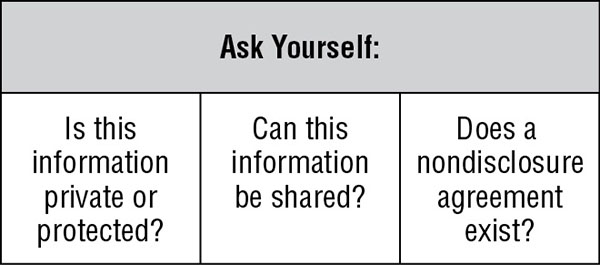
FIGURE 1.12 Handling information
Trade Secrets An organization’s trade secrets or private information should not be used for personal gain. Understanding what information may be shared with vendors, other organizations, or even coworkers is important. In practice, there are often gray areas where the breach of information is not as obvious. Being conscious and sensitive about your organization’s information can make a big difference. If ever in doubt, always ask.
Restricted Access Working with the government is a great example of when data sharing can be sensitive. The fines and criminal penalties that can be incurred with breaches can be substantial when dealing with medical, financial, and other personally identifiable data. One governmental agency does not always have access to data from another, separate governmental agency. Depending on the data, others may have restricted access or no access at all. Restricted access isn’t limited to governmental data; similar restrictions occur in the private sector as well. One department within an organization may not always have access to data from another department. Think of the sensitive nature of information housed within the human resources department. An employee’s file may not always be accessible to department heads or others. It is a mistake to assume that others should have access to data because you believe it is logical that they do.
Nondisclosure Agreements It is your responsibility to make sure vendors or organizations that will have access to sensitive data sign and understand the appropriate nondisclosure agreements before you release the data. Clearly, make sure there is key stakeholder support, including from the legal department, in the release of sensitive information.
Intellectual Property You are likely at some point to come into contact with intellectual property. The business or person who created the protected material or item owns the intellectual property. Intellectual property typically includes the following items:
- Items developed by an organization that have commercial value but are not tangible
- Copyrighted or trademarked material, such as books, software, and artistic works
- Ideas, products, or processes that are patented
- An industrial process, a business process, or a manufacturing process developed by the organization for a specific purpose
You might have to pay royalties or request written permission to use the property. Intellectual property should be protected just like sensitive or confidential data.
Respect
Demonstrating respect involves how you conduct yourself, the way you treat others and the resources around you, and listening to the viewpoints of others. Respect is something that should be exhibited on a personal and professional level. Among other things, the level of respect you earn will be based on how well you do the following:
- Exhibit a professional demeanor
- Handle ethics violations
- Demonstrate a sense of cultural awareness
- Interpret experiences
Exhibiting Professional Demeanor
Exhibiting a professional demeanor is an important part of business. You are responsible for your own actions and reactions. Here are some examples of maintaining a professional demeanor and encouraging professional demeanor within others:
- Controlling your emotions and your reactions in questionable situations.
- Notifying the project team during the kickoff meeting where they can find a copy of organizational policies regarding conflict of interest, cultural diversity, standards and regulations, customer service, and standards of performance.
- Coaching and influencing team members who exhibit nonprofessional attitudes or behaviors to conform to the standards of conduct expected by you and your organization. As the project manager, it is your job to ensure that team members act professionally because they represent you and the project.
Reporting Ethics Violations
One of the responsibilities that falls to you as a project manager is the responsibility to report violations of the PMP® code of conduct. To maintain integrity of the profession, PMP® credential holders must adhere to the code of conduct that makes all of us accountable to one another. This includes notifying PMI® when you know a violation has occurred and you’ve verified the facts. The PMI® Code of Ethics and Professional Conduct includes the following violations:
- Conflicts of interest
- Untruthful advertising
- Falsely claiming PMP® experience and credentials
- Appearances of impropriety
Demonstrating Cultural Awareness
As project teams and organizations become increasingly more diverse, the need for a heightened awareness of cultural influences and customary practices becomes critical. Today, it’s common for project teams to be spread out globally. It is rare not to come into contact with someone from another culture. For example, you may encounter some or all of the following:
- Virtual project teams with team members based in different physical locations
- Internal project stakeholders spread among offices globally
- Offshore vendors or suppliers
- Offshore partners
- Project team members who, while physically located in the same office, are from different cultures
It is important not to attempt to force your own culture or customs on others. When in a different country, you will need to respect the local customs. At the same time, it is not acceptable to do something that violates your ethics and the ethics of your company.
As part of cultural awareness, you will need to be proactive in protecting yourself and your staff from experiencing culture shock. In order to do this, it becomes important to devote time to diversity training as needed and to always demonstrate respect for your neighbors, as follows:
Culture Shock Working in a foreign country can bring about an experience called culture shock. Culture shock involves a separation from what you would normally expect. This can cause disorientation, frustration, breakdown of communication, and confusion. Here are some ways to prepare yourself and protect against culture shock (Figure 1.13 ):
- Read about the country you’re going to work in before you go.
- Become familiar with customs and acceptable practices in foreign countries where you have dealings or will be visiting.
- When in doubt about a custom or situation, ask your hosts or a trusted contact from the company for guidance.
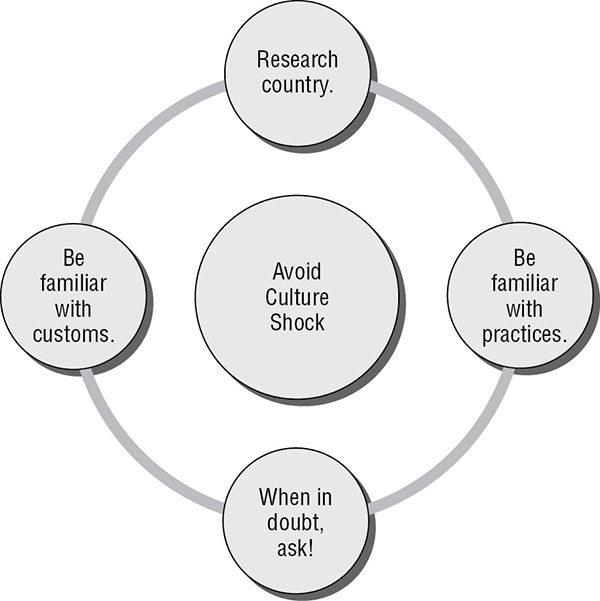
FIGURE 1.13 Avoiding culture shock
Diversity Training Project team members may be from different countries or cultures. Providing your team members with training helps to prevent cultural or ethical differences from impacting the project.
Diversity training makes people aware of differences between cultures and ethnic groups and helps them gain respect and trust. Training involving the company culture should also be provided so that project team members understand how the organization functions.
Building Relationships Some cultures require that a relationship be established before business can be conducted. Building that relationship may take days, depending on the culture.
Building relationships is valuable, regardless of whether a culture requires it. On the flip side, as you are building relationships, remember that you should not impose your beliefs on others because that is not the purpose of building relationships. Instead, building a relationship with others creates an atmosphere of mutual trust and cooperation. In this environment, all aspects of project planning and management, including negotiating and problem solving, become easier and smoother to navigate.
Interpreting Experiences
As part of exhibiting respect, it’s important to be conscious of how experiences are interpreted and perceived. This is relevant on both ends of the communication spectrum. Others may interpret your actions in a way that you did not intend. Likewise, you may misinterpret the actions of others. Remember the following:
- Each member of your team brings a unique set of experiences to the project. Those experiences influence perception, behavior, and decisions.
- Your perception of a situation is influenced by your experiences and might be very different from the perceptions of others.
- Always give others the benefit of the doubt and ask for clarification if you think there is a problem.
- Avoid allowing feelings or emotions to get in the way of how you interpret a situation.
Fairness
According to the PMI® Code of Ethics and Professional Conduct, you have a responsibility to report to the stakeholders, customers, or others any actions or circumstances that could be construed as a conflict of interest. Avoiding conflicts of interest is a part of exhibiting fairness. Fairness includes the following:
- Treating everyone equally, without favoritism or discrimination
- Appropriately representing yourself and your organization to avoid conflict-of-interest situations, and quickly reporting any situation if conflict of interest occurs
- Maintaining impartiality in your decision-making process
A conflict of interest involves putting your personal interests above the interests of the project or using your influence to cause others to make decisions in your favor without regard for the project outcome. As Figure 1.14 illustrates, any of the following could be construed as conflicts of interest and compromise fairness:
- Not revealing your active associations and affiliations
- Accepting vendor gifts
- Using stakeholder influence for personal reasons
- Participating in discrimination
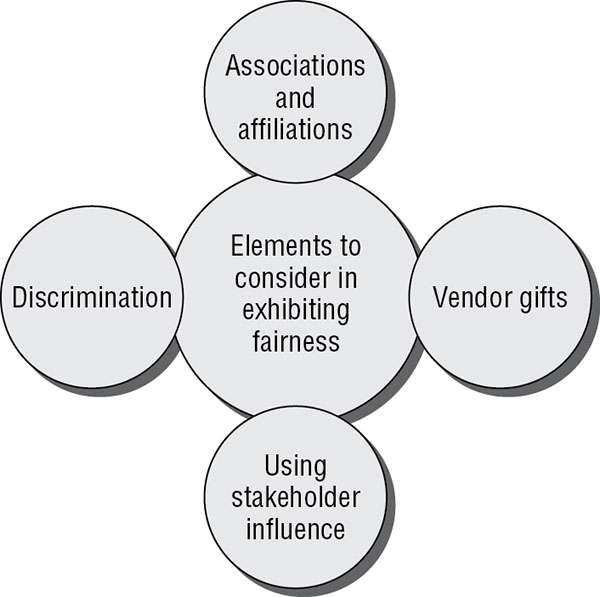
FIGURE 1.14 Elements to consider in exhibiting fairness
Associations and Affiliations In maintaining associations and affiliations, it’s important to consider whether any conflicts of interest exist as a result. For instance, sitting on the decision-making committee of a company that wins a bid for a contract relating to your project constitutes a conflict of interest. Even if you do not influence the decision in any way, others will assume that a conflict of interest occurred. This is also the case in personal associations—for instance, awarding a project to a relative, spouse, and so forth.
When these types of situations occur, do the following:
- Inform the project sponsor and the decision committee of the association or affiliation.
- Refrain from participating in the award decision committee.
- In cases of a contract with a personal association, appoint someone else in your organization to administer the contract and make the payments for the work performed.
- Document all of the decisions you make regarding the activities performed by the association and keep them with the project files.
Vendor Gifts Vendor gifts are not uncommon. Vendors and suppliers often provide their customers and potential customers with lunches, gifts, ballgame tickets, and the like. However, some professionals are not allowed to accept gifts in excess of a certain dollar amount. This might be driven by company policy or the department manager’s policy. Accepting vendor gifts may be construed as a conflict of interest—no matter how small the gift is. It is your responsibility to know the policy on accepting gifts and inform the vendor if they go beyond the acceptable limits. Likewise, do not give inappropriate gifts to others or attempt to influence a decision for personal gain.
Stakeholder Influence Some stakeholders have a great deal of authority. As you engage with stakeholders who have a lot of power and influence, you should never use these engagements for your own personal benefit. The interests of the project or organization should be first and foremost when dealing with these powerful stakeholders. This is another potential area for conflict of interest. Keep in mind these guidelines:
- Weigh your decisions with the objectives of the project and the organization in mind—not your own personal gain.
- Do not use stakeholder influence for personal gain, such as receiving a promotion, bonus, or similar reward.
Discrimination Maintaining a strong level of fairness is important on many levels, as you have seen so far. In practice, we sometimes fall prey to favoritism without realizing it. When issuing assignments, promotions, and the like, always use strong professional reasoning when making decisions. Choosing someone simply because you enjoy working with them is poor judgment and represents a conflict of interest.
It is also important to be conscious of discriminating against others. Whether based on age, disability, religion, sexual orientation, or personality, discrimination on any level is not acceptable. Remember that the PMI® Code of Ethics and Professional Conduct also requires you to report this type of behavior exhibited by someone else.
Honesty
You should be aware of several aspects of honesty that you must uphold (as shown in Figure 1.15 ):
- Report the truth regarding project status and circumstances.
- Avoid deception.
- Make only truthful statements.
- Be honest about your own experience.
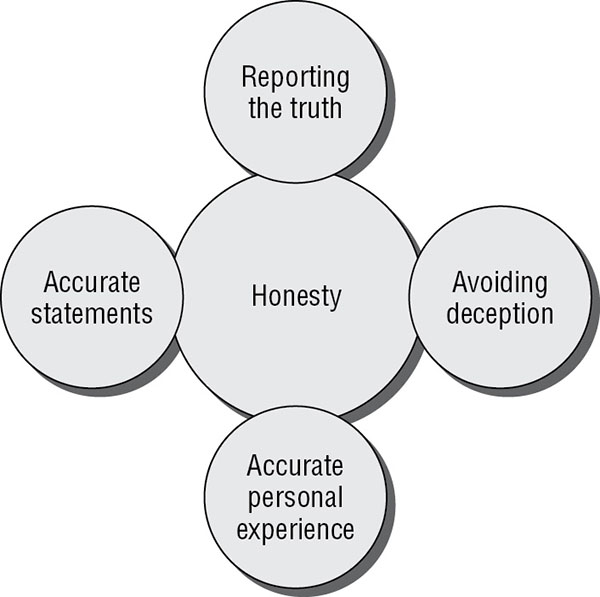
FIGURE 1.15 Elements of honesty
Reporting Truthfully Honesty involves information regarding your own background and experience as well as information about the project circumstances. Benefit to the project, and not your personal gain, should be the influencing factor when billing a customer or working on a project. Experiencing a personal gain as a result of your work is positive, but making a project decision simply to result in a personal gain is not.
As a project manager, you are responsible for truthfully reporting all information in your possession to stakeholders, customers, the project sponsor, and the public when required. This includes situations where personal gain is at stake. Always be truthful about the situation and up front regarding the project’s progress. It is important.
Avoiding Deception At times, being honest can feel difficult. In some cases, it may result in the end of a project, losing a job, missing out on a bonus, or other consequences that impact you and your team personally. Deceiving others and making false statements to prevent unfavorable consequences are not acceptable ways of handling situations. In terms of a project, telling the truth is a necessity.
Making Truthful Statements Part of managing a good team involves leading by example. This includes making truthful statements, not just on your PMP® application but in the day-to-day management of a project. In some cases, delicate situations might present themselves; this is where your general management skills come into play. Being truthful doesn’t mean being disrespectful, and a project manager must understand how to present the truth respectfully.
Representing Personal Experience
Being honest about your personal experience is just as important as not deceiving others. You may have heard that enhancing a résumé is a standard practice in business. While creating a résumé that greatly highlights your experiences and credentials is recommended, exaggerating experience or clearly embellishing credentials is unacceptable. This is equivalent to making false statements.
Correctly represent yourself on your PMP® application as well. Accurately stating your work experience, credentials, and background is an important part of maintaining high integrity.
The project management community has put together a variety of resources to communicate the values of the PMI® Code of Ethics, including video tutorials describing ethical conduct. Additionally, tools are available to help you work through a dilemma if you find yourself unsure of what to do in a certain situation. For more information, please visit the PMI® website at www.pmi.org/about/ethics.
Advancing the Industry
Promoting good project management and advancing the industry are part of your role as a project management professional. Professional knowledge involves knowledge of project management practices as well as specific industry or technical knowledge required to complete an assignment. As part of maintaining your credential, you have the following responsibilities:
- To apply project management knowledge to all your projects
- To educate others regarding project management practices by keeping them up-to-date on best practices, training your team members to use the correct techniques, informing stakeholders of correct processes, and then sticking to those processes throughout the course of the project
- To promote interaction among stakeholders
Becoming knowledgeable in project management best practices and staying abreast of the industry are important. Figure 1.16 touches on these responsibilities.
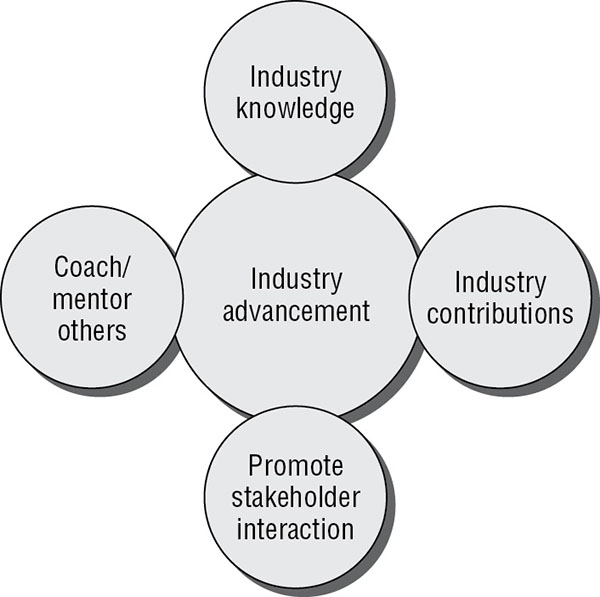
FIGURE 1.16 Elements of industry advancement
Enhancing Your Industry Knowledge
Furthering knowledge in the field of project management (your own and others) is a part of your responsibility as a project manager. Project management is a growing field, which makes staying abreast of project management practices, theories, and techniques an ongoing process. For this reason, PMI® requires that once you achieve your PMP® certification, you maintain the credential by earning a given number of professional development units (PDUs) every three years. PDUs ensure that your knowledge of the industry and project management practices remains current. There are several ways to earn PDUs, such as taking project management classes, reading industry books and magazines, speaking on the subject of project management, and so forth. You can find additional details on the PMI® website (www.PMI.org).
Here are some ways that you can further and enhance your project management education:
- Join a local PMI® chapter.
- Read the PMI® monthly magazines.
- Take educational courses offered through PMI® chapters or other project management training companies.
Remember that as a project manager, you should be proactive in looking for ways to further enhance your skills and knowledge of the industry.
Contributing to the Industry
As a project manager you have the responsibility of not only furthering your own level of knowledge and skill set but also contributing to the knowledge base itself. This includes actions such as the following:
- Coaching and mentoring others within the field
- Contributing to the knowledge base itself, such as through volunteer efforts, writing articles relating to project management, and conducting research and studies that enhance or add to the industry
- Supporting other project managers
Promoting Stakeholder Interaction
Within a project, there can be a small handful to dozens of stakeholders. The greater the number of stakeholders, the more complex project communication and control become. Throughout this book, we review how stakeholders tend to have varying interests. Although everyone wants the project to succeed, the agendas may vary. Ways to promote interaction among stakeholders include the following:
- Working toward balancing their interests, requirements, and expectations
- Reducing the amount of conflict within the project
- Encouraging collaboration among the departments
Be sure to apply all of the stakeholder management techniques that we will cover later in this book from within the Project Communications Management Knowledge Area.
Review Questions
-
The following are characteristics of a project, except:
- It is temporary in nature.
- It is continuous.
- It is unique.
- It has a definitive end.
-
When is a project considered successful?
- All deliverables have been completed.
- The phase completion has been approved.
- Stakeholder expectations have been met.
- The customer has provided final payment.
-
You are currently managing multiple projects relating to a high-profile build-out of a major retail center. The project is extensive, with a two-year timeline. Bob is the project manager responsible for the east block of the build-out, and Sally is the project manager responsible for the north block of the build-out. Both Bob and Sally report to you. Your role can best be described as:
- Lead project manager
- Department manager
- Program manager
- Portfolio manager
-
Which of the following is the oldest organization type?
- Functional organization
- Projectized organization
- Matrix organization
- Balanced matrix organization
-
A project management office (PMO) is responsible for the following activities, except:
- Measuring project performance and suggesting corrective action
- Ensuring efficient use of resources toward a specific business goal
- Evaluating completed project for adherence to project plan
- Maintaining and archiving project documentation for future use
-
During a planning meeting, a discussion takes place to decide which resource will be assigned to perform an activity that will be fast-tracked. As the project manager, you unilaterally decide to assign Fred to the activity. What type of organizational structure is this?
- Functional organization
- Projectized organization
- Matrix organization
- Balanced matrix organization
-
All of the following are project management process groups, except:
- Integration
- Planning
- Executing
- Closing
-
During which process group are costs the highest?
- Planning
- Executing
- Monitoring and Controlling
- Closing
-
The concept that each element within a cycle is results oriented and becomes an input into the next cycle describes which of the following?
- Project management processes
- Phases
- Project life cycle
- Plan-Do-Check-Act cycle
-
All of the following statements are true, except:
- It is the job of the project manager to ensure that information is explicit, clear, and complete.
- A project manager must possess a strong knowledge of finance and accounting principles.
- Organizational and planning skills are an important skill set for a project manager to possess.
- Power is a technique that the project manager may use to influence people.
-
Which of the following best describes the level of authority that a project manager has within a functional organization?
- High to ultimate authority
- Authority to assign resources
- Minimal to no authority
- Authority to recommend resources
-
The PMBOK® Guide suggests that projects follow a series of project management phases that make up the project life cycle. Which answer represents the phases of the project life cycle?
- Planning, Acting, Doing, and Checking
- Initiating, Planning, Executing, Monitoring and Controlling, and Closing
- Discovery, Designing, Execution, and Finishing
- Initiating, Planning, Performing, and Closing Out
-
General management skills are a necessary foundation for the work of a project manager. Which of the following are not general management skills a project manager would need?
- Data management skills
- Communication skills
- Conflict management skills
- Budgeting skills
-
What two actions are performed as a part of the Initiating process group?
- Hold the project kickoff meeting and perform stakeholder identification
- Develop the project charter and project kickoff meeting
- Create the project plan and develop the project charter
- Develop the project charter and stakeholder identification
-
What actions are performed as a part of the Closing process group?
- Accepting project deliverables
- Managing stakeholder expectations
- Closing out all vendor contracts
- Finalizing project work
